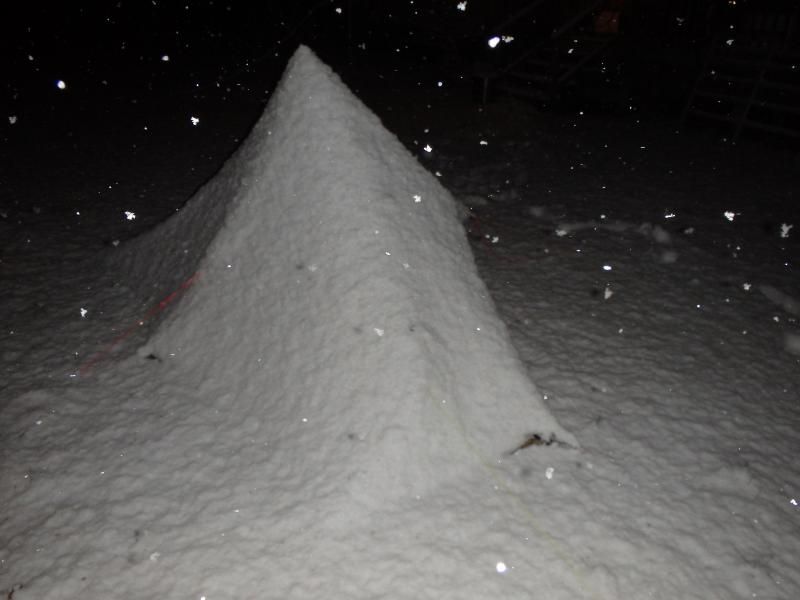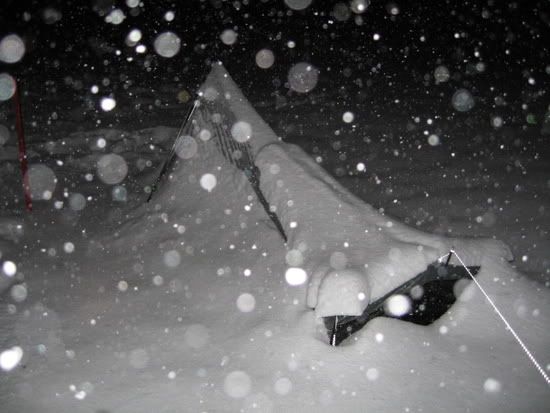Re: Cheap and light storm shelter
Thu 11 Sep, 2014 9:40 pm
Re: Cheap and light storm shelter
Fri 12 Sep, 2014 7:56 am
Re: Cheap and light storm shelter
Fri 12 Sep, 2014 8:32 am
Re: Cheap and light storm shelter
Fri 12 Sep, 2014 8:47 am
Re: Cheap and light storm shelter
Fri 12 Sep, 2014 9:36 am
I would not use it for that , silnylon is a lot stronger than soft tyvek
We (TT) kept the Sublite Tyvek going for a while because it does very well in hot humid weather but it wasn't meant for windy/rainy weather.
There was a discussion at BPL about Cuben and winter tents.
My take is that manufacturers know that snow sticks to Cuben and it has no give so makes the use of that laminate a bit too risky for the purpose.
(just my opinion...)
When I pointed out, in that BPL thread , that several mainstream manufacturers have used Cuben but not for the main tent structure ( in a winter tent) the point was totally ignored and maybe correctly so, but not from my point of view.
Re: Cheap and light storm shelter
Fri 12 Sep, 2014 10:30 am
Can Cuben be treated with spray-on Scotchguard?
Should I look at Silnylon instead and carry the extra weight?
The previous discussion on using the S2S poncho and a bivvysac as emergency shelter was responsible for thinking about this shelter option
Re: Cheap and light storm shelter
Fri 12 Sep, 2014 11:18 am
Re: Cheap and light storm shelter
Fri 12 Sep, 2014 11:44 am
Re: Cheap and light storm shelter
Fri 12 Sep, 2014 12:33 pm
Re: Cheap and light storm shelter
Fri 12 Sep, 2014 12:44 pm
Re: Cheap and light storm shelter
Fri 12 Sep, 2014 2:45 pm
Re: Cheap and light storm shelter
Sat 13 Sep, 2014 8:37 am
I am guessing it would take 4 linear meters and another 120 grams for the carbon fiber arrow shafts and the titanium pegs
Re: Cheap and light storm shelter
Sat 13 Sep, 2014 8:59 am
Re: Cheap and light storm shelter
Sat 13 Sep, 2014 9:01 am
Re: Cheap and light storm shelter
Sat 13 Sep, 2014 9:30 am
Giddy_up wrote:CF 8 is 0.78oz/yard. There is a lighter version again, but given this is a storm shelter I would imagine that this is as light as you would go. Add in seams with tape and some hardware such as line locks etc....your going to get something outrageously light.
And also outrageously costly but perhaps the boss will think I'm worth saving?
Re: Cheap and light storm shelter
Sat 13 Sep, 2014 9:43 am
Re: Cheap and light storm shelter
Sat 13 Sep, 2014 2:50 pm
Moondog55 wrote:Giddy_up wrote:CF 8 is 0.78oz/yard. There is a lighter version again, but given this is a storm shelter I would imagine that this is as light as you would go. Add in seams with tape and some hardware such as line locks etc....your going to get something outrageously light.
And also outrageously costly but perhaps the boss will think I'm worth saving?
Your definitely worth saving!!!!!!!!!
Re: Cheap and light storm shelter
Mon 15 Sep, 2014 8:41 pm
http://www.backpackinglight.com.au/stor ... nt/dp/9445
With the Cuben at $35- a meter this is about the same cost, I wonder how strong it is
Re: Cheap and light storm shelter
Thu 18 Sep, 2014 11:18 am
Makes DIY worthwhile
Simon is sending me 3.5 meters of Silnylon and as a start I am going to make a basic poncho style tarp type shelter to get me started
I'm looking for ideas for a solo shelter that will work with the minimum lines of stitching and that will work using either the skis or the ski poles as support. I'm working on the assumption that I will be able to dig a shallow snow trench in winter.
I know very little about the strength characteristics of Silnylon but all of my ponchos here use the width of the fabric and just cut to length with any stress being taken on the side folds. Is a center seam stronger or weaker than the base fabric?
Re: Cheap and light storm shelter
Thu 18 Sep, 2014 10:39 pm
The point loads of a seam tend to not spread the weight as well, leading to broken seams.
Re: Cheap and light storm shelter
Fri 19 Sep, 2014 7:57 am
Re: Cheap and light storm shelter
Fri 19 Sep, 2014 11:50 am

as it was with a photo that one of the Cuben tent manufacturers used to post to show how they hold up under snow, what I see here is that the material tends to hold on to it (note the steep walls) and that can't be good on top of a UL shelter (would be good if building an igloo)
Re: Cheap and light storm shelter
Mon 28 Sep, 2015 9:20 am
But I have found a commercial build that seems to be exactly what I was considering
http://www.backcountrygear.com/ultralig ... -tent.html
Sized down a touch for solo use and in LW Silnylon and using my skis for the support it seems it would allow more safety than a bivvy sac because I could brew up even if a strong wind was blowing
This chould be made in Cuben I suppose if I can afford it
Re: Cheap and light storm shelter
Mon 28 Sep, 2015 3:33 pm
Re: Cheap and light storm shelter
Mon 28 Sep, 2015 3:53 pm
What is going for it tho is the light weight
For solo use I usually have a real tent, I'm looking a a replacement for my poncho shelter to carry in my Winter EDC
Re: Cheap and light storm shelter
Mon 28 Sep, 2015 8:15 pm
Google may find you some pictures.
Re: Cheap and light storm shelter
Mon 28 Sep, 2015 9:07 pm
Clearly this is not the kind of budget that average people talk about for an emergency shelter - but is this the kind of weight / design that you were thinking about? I have a pocket tarp that I carry as a three-season emergency shelter - and it seems more resilient that I would have thought!
Re: Cheap and light storm shelter
Tue 29 Sep, 2015 7:33 am
Re: Cheap and light storm shelter
Tue 29 Sep, 2015 8:33 am
Re: Cheap and light storm shelter
Tue 29 Sep, 2015 9:31 am
Given you experience would you say tho that the design coincides with my needs for something lightweight and wind resistant? It's a given that you get condensation in this sort of shelter but survival needs in an Alpine blow mean comfort in the least concern
Also in all likely hood it would be used in conjunction with a shallow trench and with my skis as the supports
© Bushwalk Australia and contributors 2007-2013.

